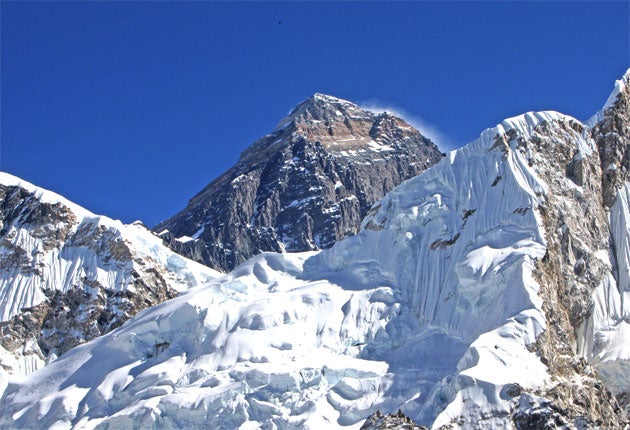Everest team forced to leave sick British climber to die

At one o'clock in the afternoon, the British climber Peter Kinloch was on the roof of the world, in bright sunlight, taking photographs of the Himalayas below, "elated, cheery and bubbly".
But Mount Everest is now his grave, because only minutes later, he suddenly went blind and had to be abandoned to die from the cold.
As the team descended, Mr Kinloch's guides noticed that he seemed to lose co-ordination. He would slip and stumble, then resume walking normally. After an hour, he made a surprising request to the team leader, David O'Brien, to be shown how to get down the ladders. At first he said he was having difficulty seeing, then he admitted that he could not see anything.
It took four hours for Mr O'Brien and a sherpa to help the stricken climber down to Mushroom Rock, barely 1,000ft below the summit. Two more sherpas arrived and for the next eight hours they all struggled to bring Mr Kinloch,28, down the mountain, administering drugs and oxygen. But they were now dangerously close to needing rescue themselves, and had to abandon him and struggled back into camp at 5.30am, exhausted and suffering from hypothermia and frostbite.
Mr Kinloch's body is still in Mount Everest's "death zone" and may never be recovered. He is the 30th climber to die on the mountain in the past five years. He died last Wednesday but the news was made public only yesterday, on the EverestNews website.
"Peter seemed to be a fit young Scotsman with an interesting life of experiences," one of his fellow climbers wrote. "On the way up the final obstacles, Peter was in good spirits, moving steadily and sure-footedly together with our team. Everyone was in fine spirits and good health.
"On the summit Peter was elated cheery and bubbly. Earlier, during the expedition, while dining with the team, he had said that climbing Everest would be the realisation of a dream. While standing atop Everest, Peter took summit photos with the team. Conditions were sunny, but extremely cold, windy, with blowing snow."
The IT specialist, who worked for Merseyside Police, had an ambition to climb the highest peak on each of the seven continents. He had conquered four. Everest, at 29,035ft, was the fifth. After that, he planned to tackle Carstensz Pyramid in Indonesia and Mount Vinson in Antarctica. His plan was that on every summit he would wear the team hat of Inverness Caledonian Thistle FC. He was using the climbs to raise awareness for the charity OCD Action, which aids people with obsessive compulsive disorder.
His father, also Peter Kinloch, a former police officer living on Skye, said: "He used to go climbing mountains when he was a little boy. Being in the hills has been with him all his life.
"Taking on the highest peaks always carries an element of risk and all mountaineers know that. Peter prepared himself very carefully and was supremely physically fit and not the sort of person to take risks lightly.
"He was never gung-ho and followed a carefully set-out training regime. In some ways, the loss is easier to take in that he had achieved his lifelong ambition."
Dangers at Altitude
* Retinal haemorrhages – bleeding from the cells at the back of the eye – are a relatively common complaint of mountain climbers. High altitude causes the blood to thicken, increasing blood pressure, which can lead to the seepage of blood from cells into surrounding tissues.
* Some researchers have found that more than a quarter of climbers on an Everest expedition are affected by retinal haemorrhages. Normally, they are minor, with no noticeable effect on vision, and resolve themselves within weeks of a return to low altitudes. But in Peter Kinloch's case it appears the effects were acute and extreme, causing total loss of vision, which led to deadly consequences.
Jeremy Laurance
Join our commenting forum
Join thought-provoking conversations, follow other Independent readers and see their replies
Comments
Bookmark popover
Removed from bookmarks